ASUSTeK Computer K013C ASUS Tablet User Manual R1
ASUSTeK Computer Inc ASUS Tablet R1
User Manual_R1.pdf

User Guide
E10063
ASUS Tablet
First Edition / January 2015

Charging your device
Ensure to fully charge your ASUS Tablet before using it in
battery mode for extended periods. Remember that the power
adapter charges your ASUS Tablet as long as it is plugged into
an AC power source. Be aware that it takes much longer to
charge the ASUS Tablet when it is in use.
IMPORTANT! Do not leave the ASUS Tablet connected to
the power supply once it is fully charged. ASUS Tablet is not
designed to be left connected to the power supply for extended
periods of time.
Airplane precautions
Contact your airline provider to learn about related inight
services that can be used and restrictions that must be followed
when using your ASUS Tablet in-ight.
IMPORTANT! You can send your ASUS Tablet through x-ray
machines (used on items placed on conveyor belts), but do not
expose them from magnetic detectors and wands.
Safety precautions
This ASUS Tablet should only be used in enviroments with
ambient temperatures between 0°C to 35°C (32°F to 95°F).
Long time exposure to extremely high or low temperature
may quickly deplete and shorten the battery life. To ensure the
battery’s optimal performance, ensure that it is exposed within
the recommended environment temperature.
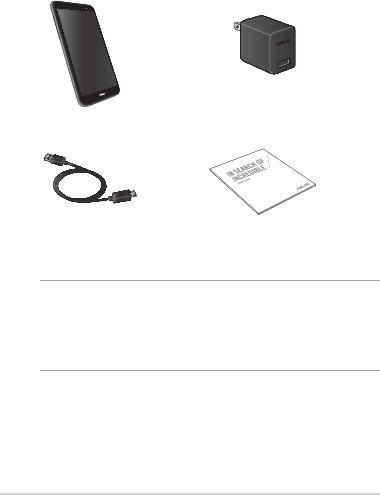
ASUS Tablet
3
Package contents
NOTES:
• If any of the items is damaged or missing, contact your
retailer.
• The bundled power adapter varies with country or region.
ASUS Tablet Power adapter
ASUS Tablet
Micro USB cable Technical documentations and
warranty card
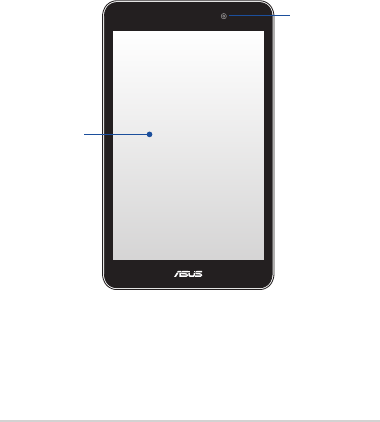
ASUS Tablet
4
Your ASUS Tablet
Front camera
Touch screen panel
Front view

ASUS Tablet
5
Rear view
* The microSD card slot supports microSD, microSDHC, and microSDXC card formats.
Micro USB 2.0 port
MicroSD card slot*
Speaker/Headset port
Microphone
Audio speaker
Rear camera
NFC
Power button
Volume button
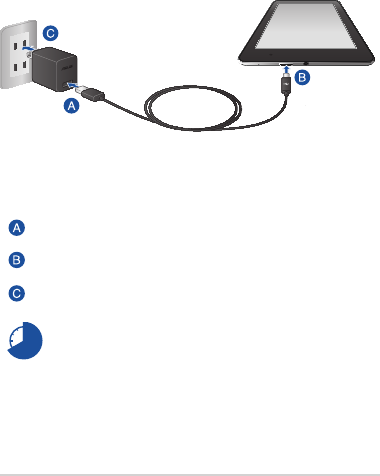
ASUS Tablet
6
Charging your ASUS Tablet
To charge your ASUS Tablet:
Connect the micro USB cable to the power adapter.
Plug the micro USB connector into your ASUS Tablet.
Plug the power adapter into a grounded power outlet.
Charge your ASUS Tablet for eight (8) hours before
using it in battery mode for the rst time.

ASUS Tablet
7
IMPORTANT!
• Use only the bundled power adapter and micro USB cable
to charge your ASUS Tablet. Using a dierent power adapter
may damage your ASUS Tablet.
• Peel the protective lm o from the power adapter and micro
USB cable before charging the ASUS Tablet to prevent risk or
injury.
• Ensure that you plug the power adapter to the correct power
outlet with the correct input rating. The output voltage of this
adapter is DC 5.2 V, 1.35 A.
• When using your ASUS Tablet while plugged-in to a power
outlet, the grounded power outlet must be near the unit and
easily accessible.
• Do not place objects on top of your ASUS Tablet.
NOTES:
• Your ASUS Tablet can be charged via the USB port on the
computer only when it is in sleep mode (screen o) or turned
o.
• Charging through the USB port of a computer may take
longer time to complete.
• If your computer does not provide enough power for
charging your ASUS Tablet, charge your ASUS Tablet via the
grounded power outlet instead.

ASUS Tablet
8
Appendices
Federal Communications Commission
Statement
This device complies with FCC Rules Part 15. Operation is
subject to the following two conditions:
• This device may not cause harmful interference.
• This device must accept any interference received, including
interference that may cause undesired operation.
This equipment has been tested and found to comply with
the limits for a class B digital device, pursuant to Part 15 of the
Federal Communications Commission (FCC) rules. These limits
are designed to provide reasonable protection against harmful
interference in a residential installation. This equipment
generates, uses, and can radiate radio frequency energy and,
if not installed and used in accordance with the instructions,
may cause harmful interference to radio communications.
However, there is no guarantee that interference will not occur
in a particular installation. If this equipment causes harmful
interference to radio or television reception, which can be
determined by turning the equipment o and on, the user is
encouraged to try to correct the interference by doing one or
more of the following measures:
• Reorient or relocate the receiving antenna.
• Increase the separation between the equipment and
receiver.
• Connect the equipment into an outlet on a circuit dierent
from that to which the receiver is connected.

ASUS Tablet
9
• Consult the dealer or an experienced radio/TV technician for
help.
Changes or modications not expressly approved by the party
responsible for compliance could void the user‘s authority to
operate the equipment.
The antenna(s) used for this transmitter must not be co-
located or operating in conjunction with any other antenna or
transmitter.
RF Exposure Information (SAR)
This device meets the government’s requirements for exposure
to radio waves. This device is designed and manufactured not
to exceed the emission limits for exposure to radio frequency
(RF) energy set by the Federal Communications Commission of
the U.S. Government.
The exposure standard employs a unit of measurement
known as the Specic Absorption Rate, or SAR. The SAR limit
set by the FCC is 1.6 W/kg. Tests for SAR are conducted using
standard operating positions accepted by the FCC with the EUT
transmitting at the specied power level in dierent channels.
The highest SAR value for the device as reported to the FCC is
1.14 W/kg when placed next to the body.
Note: The country code selection is for non-US model only
and is not available to all US model. Per FCC regulation, all WiFi
product marketed in US must xed to US operation channels
only.

ASUS Tablet
10
Canada, Industry Canada (IC) Notices
This Class B digital apparatus complies with Canadian ICES-003,
RSS-210, and CAN ICES-3(B)/NMB-3(B).
This device complies with Industry Canada license-exempt
RSS standard(s). Operation is subject to the following two
conditions: (1) this device may not cause interference, and (2)
this device must accept any interference, including interference
that may cause undesired operation of the device. The IC ID for
this device is 3568A-K013.
Radio Frequency (RF) Exposure Information
The radiated output power of the Wireless Device is below
the Industry Canada (IC) radio frequency exposure limits. The
Wireless Device should be used in such a manner such that
the potential for human contact during normal operation is
minimized.
This device has been evaluated for and shown compliant with
the IC Specic Absorption Rate (“SAR”) limits when installed
in specic host products operated in portable exposure
conditions.
The FCC has granted an Equipment Authorization for this device
with all reported SAR levels evaluated as in compliance with the
FCC RF exposure guidelines. SAR information on this device is
on le with the FCC and can be found under the Display Grant
section of www.fcc.gov/oet/ea/fccid after searching on FCC ID:
MSQK013.

ASUS Tablet
11
Canada’s REL (Radio Equipment List) can be found at the
following web address:
http://www.ic.gc.ca/app/sitt/reltel/srch/nwRdSrch.
do?lang=eng
Additional Canadian information on RF exposure also can be
found at the following web address:
http://www.ic.gc.ca/eic/site/smt-gst.nsf/eng/sf08792.html
Canada, avis d’Industrie Canada (IC)
Cet appareil numérique de classe B est conforme aux normes
canadiennes ICES-003, RSS-210 et CAN ICES-3(B)/NMB-3(B).
Le présent appareil est conforme aux CNR d’Industrie
Canada applicables aux appareils radio exempts de licence.
L’exploitation est autorisée aux deux conditions suivantes: (1)
l’appareil ne doit pas produire de brouillage, et (2) l’utilisateur
de l’appareil doit accepter tout brouillage radioélectrique subi,
même si le brouillage est susceptible d’en compromettre le
fonctionnement.L’identiant IC de cet appareil est 3568A-K013.
Informations concernant l’exposition aux fréquences
radio (RF)
La puissance de sortie émise par cet appareil sans l est
inférieure à la limite d’exposition aux fréquences radio
d’Industrie Canada (IC). Utilisez l’appareil sans l de façon à
minimiser les contacts humains lors du fonctionnement normal.

ASUS Tablet
12
Ce périphérique a été évalué et démontré conforme aux limites
SAR (Specic Absorption Rate – Taux d’absorption spécique)
d’IC lorsqu’il est installé dans des produits hôtes particuliers qui
fonctionnent dans des conditions d’exposition à des appareils
portables.
Ce périphérique est homologué pour l’utilisation au Canada.
Pour consulter l’entrée correspondant à l’appareil dans la liste
d’équipement radio (REL - Radio Equipment List) d’Industrie
Canada rendez-vous sur:
http://www.ic.gc.ca/app/sitt/reltel/srch/nwRdSrch.
do?lang=eng
Pour des informations supplémentaires concernant l’exposition
aux RF au Canada rendez-vous sur :
http://www.ic.gc.ca/eic/site/smt-gst.nsf/eng/sf08792.html
This device and its antenna(s) must not be co-located or
operating in conjunction with any other antenna or transmitter,
except tested built-in radios. The County Code Selection feature
is disabled for products marketed in the US/ Canada.
Cet appareil et son antenne ne doivent pas être situés ou
fonctionner en conjonction avec une autre antenne ou un
autre émetteur, exception faites des radios intégrées qui ont
été testées. La fonction de sélection de l’indicatif du pays est
désactivée pour les produits commercialisés aux États-Unis et
au Canada.

ASUS Tablet
13
Caution :
(i) the device for operation in the band 5150-5250 MHz is
only for indoor use to reduce the potential for harmful
interference to co-channel mobile satellite systems;
(ii) the maximum antenna gain permitted for devices in the
bands 5250-5350 MHz and 5470-5725 MHz shall comply
with the e.i.r.p. limit; and
(iii) the maximum antenna gain permitted for devices in
the band 5725-5825 MHz shall comply with the e.i.r.p.
limits specied for point-to-point and non point-to-point
operation as appropriate.
(iv) Users should also be advised that high-power radars are
allocated as primary users (i.e. priority users) of the bands
5250-5350 MHz and 5650-5850 MHz and that these radars
could cause interference and/or damage to LE-LAN devices.
Le guide d’utilisation des dispositifs pour réseaux locaux
doit inclure des instructions précises sur les restrictions
susmentionnées, notamment :
(i) les dispositifs fonctionnant dans la bande 5 150-5 250 MHz
sont réservés uniquement pour une utilisation à l’intérieur
an de réduire les risques de brouillage préjudiciable aux
systèmes de satellites mobiles utilisant les mêmes canaux;

ASUS Tablet
14
(ii) le gain maximal d’antenne permis pour les dispositifs
utilisant les bandes 5 250-5 350 MHz et 5 470-5 725 MHz
doit se conformer à la limite de p.i.r.e.;
(iii) le gain maximal d’antenne permis (pour les dispositifs
utilisant la bande 5 725-5 825 MHz) doit se conformer à la
limite de p.i.r.e. spéciée pour l’exploitation point à point et
non point à point, selon le cas.
(iv) De plus, les utilisateurs devraient aussi être avisés que les
utilisateurs de radars de haute puissance sont désignés
utilisateurs principaux (c.-à-d., qu’ils ont la priorité) pour
les bandes 5 250-5 350 MHz et 5 650-5 850 MHz et que ces
radars pourraient causer du brouillage et/ou des dommages
aux dispositifs LAN-EL.

ASUS Tablet
15
IC Warning Statement
The device could automatically discontinue transmission in
case of absence of information to transmit, or operational
failure. Note that this is not intended to prohibit transmission of
control or signaling information or the use of repetitive codes
where required by the technology.
The Country Code Selection feature is disabled for products
marketed in the US/Canada. For product available in the USA/
Canada markets, only channel 1-11 can be operated. Selection
of other channels is not possible.
Federal Communication Commission (FCC)
Radiation Exposure Statement
This EUT is compliant with SAR for general population/
uncontrolled exposure limits in ANSI/IEEE C95.1-1999 and had
been tested in accordance with the measurement methods
and procedures specied in OET Bulletin 65 Supplement C. This
equipment should be installed and operated with minimum
distance of 1.5 cm between the radiator and your body.

ASUS Tablet
16
EC Declaration of Conformity
This product is compliant with the regulations of the R&TTE
Directive 1999/5/EC. The Declaration of Conformity can be
downloaded from http://support.asus.com.
Limitation of Liability
Circumstances may arise where because of a default on ASUS’
part or other liability, you are entitled to recover damages from
ASUS. In each such instance, regardless of the basis on which
you are entitled to claim damages from ASUS, ASUS is liable
for no more than damages for bodily injury (including death)
and damage to real property and tangible personal property;
or any other actual and direct damages resulted from omission
or failure of performing legal duties under this Warranty
Statement, up to the listed contract price of each product.
ASUS will only be responsible for or indemnify you for loss,
damages or claims based in contract, tort or infringement
under this Warranty Statement.
This limit also applies to ASUS’ suppliers and its reseller. It is the
maximum for which ASUS, its suppliers, and your reseller are
collectively responsible.
IC Radiation Exposure Statement
This EUT is compliant with SAR for general population/
uncontrolled exposure limits in IC RSS-102 and had been tested
in accordance with the measurement methods and procedures
specied in IEEE 1528. This equipment should be installed
and operated with minimum distance of 1.5 cm between the
radiator and your body.

ASUS Tablet
17
Prevention of Hearing Loss
To prevent possible hearing damage, do not listen at high
volume levels for long periods.
For France, headphones/earphones for this device are
compliant with the sound pressure level requirement laid down
in the applicable EN 50332-1:2000 and/or EN50332-2:2003
standard required by French Article L.5232-1.
UNDER NO CIRCUMSTANCES IS ASUS LIABLE FOR ANY OF THE
FOLLOWING: (1) THIRD-PARTY CLAIMS AGAINST YOU FOR
DAMAGES; (2) LOSS OF, OR DAMAGE TO, YOUR RECORDS OR
DATA; OR (3) SPECIAL, INCIDENTAL, OR INDIRECT DAMAGES OR
FOR ANY ECONOMIC CONSEQUENTIAL DAMAGES (INCLUDING
LOST PROFITS OR SAVINGS), EVEN IF ASUS, ITS SUPPLIERS OR
YOUR RESELLER IS INFORMED OF THEIR POSSIBILITY.

ASUS Tablet
18
CE Mark Warning
CE marking for devices with wireless LAN/ Bluetooth
This equipment complies with the requirements of Directive
1999/5/EC of the European Parliament and Commission from
9 March, 1999 governing Radio and Telecommunications
Equipment and recognition of conformity.
The highest CE SAR value for the device is 0.359 W/Kg.
This equipment may be operated in:
AT BE BG CH CY CZ DE DK
EE ES FI FR GB GR HU IE
IT IS LI LT LU LV MT NL
NO PL PT RO SE SI SK TR
DFS controls related to radar detection shall not be accessible
to the user.
Operations in the 5.15-5.25GHz band are restricted to indoor
usage only.

ASUS Tablet
19
RF Exposure information (SAR) - CE
This device meets the EU requirements (1999/519/EC) on the
limitation of exposure of the general public to electromagnetic
elds by way of health protection.
The limits are part of extensive recommendations for the
protection of the general public. These recommendations
have been developed and checked by independent scientic
organizations through regular and thorough evaluations of
scientic studies. The unit of measurement for the European
Council’s recommended limit for mobile devices is the “Specic
Absorption Rate” (SAR), and the SAR limit is 2.0 W/Kg averaged
over 10 gram of body tissue. It meets the requirements of the
International Commission on Non-Ionizing Radiation Protection
(ICNIRP).
For next-to-body operation, this device has been tested and
meets the ICNRP exposure guidelines and the European
Standard EN 62209-2 and EN 50566. SAR is measured with the
device directly contacted to the body while transmitting at the
highest certied output power level in all frequency bands of
the mobile device.
Rechargeable Battery Recycling Service in
North America
For US and Canada customers, you can
call 1-800-822-8837 (toll-free) for recycling
information of your ASUS products’
rechargeable batteries.

ASUS Tablet
20
India RoHS
This product complies with the “India E-waste (Management
and Handling) Rule 2011” and prohibits use of lead, mercury,
hexavalent chromium, polybrominated biphenyls (PBBs) and
polybrominated diphenyl ethers (PBDEs) in concentrations
exceeding 0.1% by weight in homogenous materials and 0.01%
by weight in homogenous materials for cadmium, except for
the exemptions listed in Schedule-II of the Rule.
ASUS Recycling/Takeback Services
ASUS recycling and takeback programs come from our
commitment to the highest standards for protecting our
environment. We believe in providing solutions for you to
be able to responsibly recycle our products, batteries, other
components as well as the packaging materials. Please go to
http://csr.asus.com/english/Takeback.htm for detailed recycling
information in dierent regions.
Power Safety Requirement
Products with electrical current ratings up to 6A and weighing
more than 3Kg must use approved power cords greater than or
equal to: H05VV-F, 3G, 0.75 mm2 or H05VV-F, 2G, 0.75 mm2.
Coating notice
IMPORTANT! To provide electrical insulation and maintain
electrical safety, a coating is applied to insulate the device
except on the areas where the I/O ports are located.

ASUS Tablet
21
Green ASUS notice
ASUS is devoted to creating environment-friendly products and
packaging to safeguard consumers’ health while minimizing
the impact on the environment. The reduction of the number
of the manual pages complies with the reduction of carbon
emission.
For the detailed user manual and related information, refer to
the user manual included in the ASUS Tablet or visit the ASUS
Support Site at http://support.asus.com/.
Regional notice for Singapore
This ASUS product complies with IDA
Standards.
Complies with
IDA Standards
DB103778
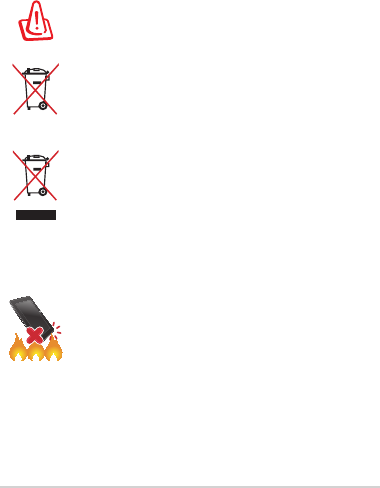
ASUS Tablet
22
Proper disposal
Risk of explosion if battery is replaced by
an incorrect type. Dispose of used batteries
according to the instructions.
DO NOT throw the battery in municipal waste. The
symbol of the crossed out wheeled bin indicates
that the battery should not be placed in municipal
waste.
DO NOT throw the ASUS Tablet in municipal
waste. This product has been designed to enable
proper reuse of parts and recycling. The symbol
of the crossed out wheeled bin indicates that the
product (electrical, electronic equipment and
mercury-containing button cell battery) should
not be placed in municipal waste. Check local
regulations for disposal of electronic products.
DO NOT throw the ASUS Tablet in re. DO NOT
short circuit the contacts. DO NOT disassemble the
ASUS Tablet.

ASUS Tablet
23
Model name: K013C (ME176CE)
Copyright Information
No part of this manual, including the products and software
described in it, may be reproduced, transmitted, transcribed,
stored in a retrieval system, or translate into any language in
any form or by any means, except documentation kept by the
purchaser for backup purposes, without the express written
permission of ASUSTeK COMPUTER INC. (“ASUS”).
ASUS and ASUS Tablet logo are trademarks of ASUSTek
Computer Inc.
Information in this document is subject to change without
notice.
Copyright © 2015 ASUSTeK COMPUTER INC. All Rights
Reserved.
Manufacturer ASUSTek COMPUTER INC.
Address, City 4F, No. 150, LI-TE RD., PEITOU,
TAIPEI 112, TAIWAN
Country TAIWAN
Authorized
Representative
in Europe
ASUS COMPUTER GmbH
Address, City HARKORT STR. 21-23, 40880 RATINGEN
Country GERMANY
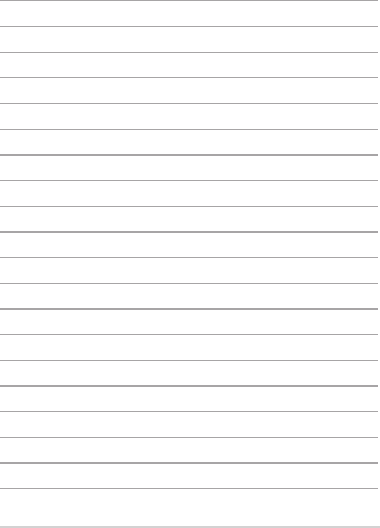
ASUS Tablet
24


support.asus.com
15060-XXXX0000